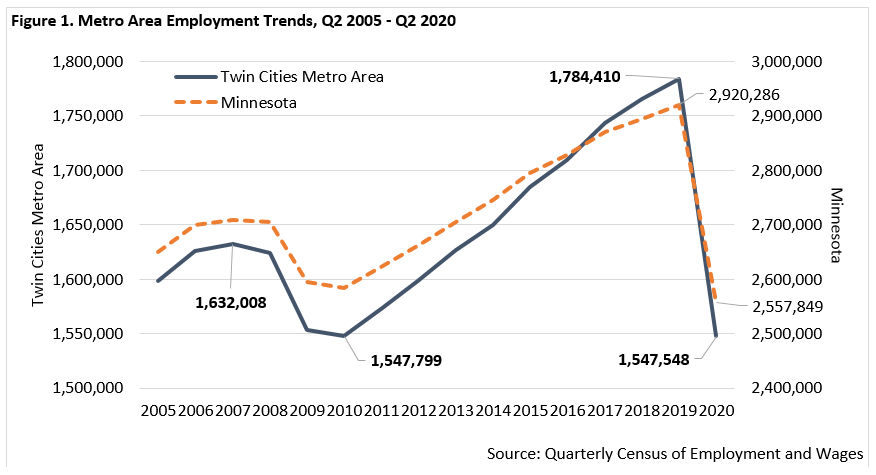 The Minneapolis-St. Paul metropolitan area is a national leader in finance, advanced manufacturing, agriculture and retailing.
The Minneapolis-St. Paul metropolitan area is a national leader in finance, advanced manufacturing, agriculture and retailing.
Medical devices, electronics and processed foods are strong suits recognized globally.
Want the freshest data delivered by email? Subscribe to our regional newsletters.
12/4/2020 9:00:00 AM
Tim O'Neill
Twin Cities Metro Area employment dropped by 13.3% – or 236,862 jobs – between the second quarter of 2019 and the second quarter of 2020, according to data from the Department of Employment and Economic Development's (DEED) Quarterly Census of Employment and Wages (QCEW). For more perspective from historic QCEW data, the Metro Area lost 84,209 jobs during the Great Recession, a decline of 5.2%. With a decline of 13.3% in 2020, the region lost nearly three times as many jobs due to COVID-19 as it did during the Great Recession!
The Twin Cities Metro Area had 87,574 establishments supplying 1,547,548 covered jobs during the second quarter of 2020. One year previous, during the second quarter of 2019, the region had 1,784,410 covered jobs. That loss of 236,862 jobs year over year in the second quarter is almost exactly the number of jobs the region gained in the nine years of employment expansion since the end of the Great Recession (+236,611 jobs) (Figure 1).

While job loss during COVID-19 was more dramatic than that of the Great Recession, job rebound has been more dramatic in 2020 as well. Recent employment data from Current Employment Statistics (CES) shows employment rebounding in the State of Minnesota and the Minneapolis-St. Paul Metropolitan Statistical Area (MSA)– with 173,573 of 230,376 jobs lost from March to April gained back by October 2020. This employment bounce in the Twin Cities Metro Area will most likely be reflected in third quarter QCEW data when released early next year.
Data from QCEW also allows us to analyze which industry sectors have been hit the hardest in the Twin Cities Metro Area due to COVID-19. It is hard to believe, but six major industry sectors lost more than 20,000 jobs between the second quarters of 2019 and 2020, including:
Zooming in, those more-specific industry sectors which lost the most jobs between the second quarters of 2019 and 2020 include:
In terms of percentage employment loss, other decimated industries include:
While some of these industries – such as those in retail trade, health care, and employment services – have already started to recover, others are struggling to return to normal, both in customer confidence and employment levels.
Contact Tim O'Neill, Labor Market Analyst.